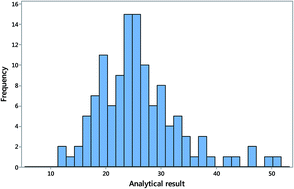Results from a round of a proficiency test in chemical measurement quite often deviate noticeably from a symmetrical distribution, throwing into doubt the worth of the mean (or a robust mean) as an apt location estimator and basis for further inferences such as attributing scores to the participants. In such instances the mode is an intuitively suitable location. However, the mode needs to be defined in terms of a procedure for estimating it and its standard error, and such procedures are necessarily computer-based. This paper offers a preliminary investigation of several procedures. Those considered were examined in respect of bias and precision. The overall conclusions were that: (a) modes are preferable location estimators when results are skewed; (b) mode estimates tend to be biased towards the skew; and (c) the biases are not likely to cause inconsistencies with visual assessment.
